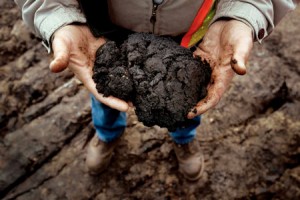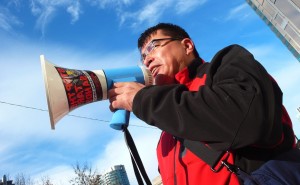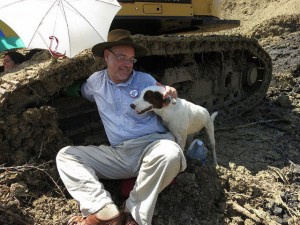 Environmentalists have drawn international attention to Canada’s tar sands, vast deposits of a particularly gooey, toxic form of petroleum called bitumen that Canada hopes to ship thousands of miles. Civil disobedience campaigns against the Keystone XL pipeline were so effective that President Obama placed construction of its northern leg on hold (and activists in Texas and Oklahoma have been relentlessly blockading construction for the southern leg).
Environmentalists have drawn international attention to Canada’s tar sands, vast deposits of a particularly gooey, toxic form of petroleum called bitumen that Canada hopes to ship thousands of miles. Civil disobedience campaigns against the Keystone XL pipeline were so effective that President Obama placed construction of its northern leg on hold (and activists in Texas and Oklahoma have been relentlessly blockading construction for the southern leg).
With the Keystone XL in jeopardy, Canada’s prime minister Stephen Harper has tried to shift gears with another plan called the Enbridge Northern Gateway, which would cut through the lands of indigenous groups and three major watersheds. Not surprisingly, this has been fiercely opposed by groups like ForestEthics, the Sierra Club, First Nations groups, and the general public (as background see Rolling Stone‘s “Keystone Moves North, Where Big Oil Is Losing”). Just this week, another investigation by ForestEthics documented how toxins from tar sands refineries are polluting communities.
There are billions of dollars at stake. And that means Big Oil and Harper have a crisis.
Their response has been to hit back hard against environmental groups as “terrorists.”
The scare tactics have worked. A recent poll showed that one in two Canadian voters are afraid of attacks by “eco-terrorists,” and would support spying on environmental groups.
Here are 7 tactics they have used to manufacture this fear:
1. Media campaigns smear environmentalists as extremists
Enbridge, the company that wants to build the Northern Gateway pipeline, has been mounting a public relations campaign, and says activists are threats to national security because they are targeting infrastructure. CEO Patrick Daniel said: “I think we’re facing a very strong, almost revolutionary movement to try to get off oil worldwide… they’re coming after what they consider to be the weak link in the whole process, and that’s the infrastructure part of it.â€
In a calculated PR move the day before federal regulatory hearings began on whether to approve the Northern Gateway, Natural Resources Minister Joe Oliver said environmentalists are “radical groups” who “threaten to hijack our regulatory system to achieve their radical ideological agenda.” Read his full letter here, in which he warns of the activists’ use of regulatory hearings and “jet-setting celebrities.”
It’s no accident that corporate PR and government PR are nearly identical. Internal documents obtained by Greenpeace Canada revealed a coordinated, joint effort to shift attitudes in the press and among elite decision-makers internationally. Environmental and indigenous groups are listed in the documents as “adversaries”; energy corporations and associations are listed as “allies.”
2. Canada’s first counter-terrorism program targets environmentalists
In the midst of those federal regulatory hearings, the Harper administration unveiled what it called “Canada’s first counter-terrorism strategy.”
“Although not of the same scope and scale faced by other countries,” the report said, “low-level violence by domestic issue-based groups remains a reality in Canada. Such extremism tends to be based on grievances—real or perceived—revolving around the promotion of various causes such as animal rights, white supremacy, environmentalism and anti-capitalism.”
The document discussed environmentalists, who have never harmed anyone, alongside the Oklahoma City bombing and the 2011 Norway massacre as examples of “domestic issue-based extremism.”
3. Harper threatens the tax status of environmental charities
Harper and Natural Resources Minister Joe Oliver cracked down on charitable environmental groups that oppose the pipelines and investigated the Tides Foundation. Harper and Oliver said the charities were receiving donations from U.S. supporters, and that this, along with the groups’ political advocacy, overstepped the bounds of a charitable organization. The recent federal budget included $8 million for the Canada Revenue Agency to audit charitable groups. Because of this, ForestEthics decided to split into two organizations so that it could continue its work.
Valerie Langer of ForestEthics Solutions said the move “shows our resolve in this very hostile climate to continue the work that we feel Canadians actually want.”
In response to the threats against charitable groups, hundreds of Canadian websites went dark.
4. New counter-terrorism unit formed to protect the oil sands
The federal government set up a RCMP-led counter-terrorism unit in Alberta to protect the oil industry from alleged attacks by activists. The new unit doubles the number of counter-terrorism cops in the area, and the 32-member team works with foreign partners to gather intelligence on potential threats to the oil and natural gas pipelines and refineries.
Assistant Commissioner Gilles Michaud denied that the unit would be used to monitor protest activity. “That being said, in our role of preventing these threats from occurring, it is important that intelligence is collected against the activities of groups before they become violent,” he said.
John Bennett of the Sierra Club Canada responded: “It’s part of their overall propaganda campaign to try to convince Canadians that environmentalists are somehow a threat—which means that most Canadians would be a threat. This is more of a political announcement than it is a police announcement.”
5. Canada sends diplomats to scare Fortune 500 corporations
Fearing the growing success of anti-tar sands campaigning, the Harper government sent Canadian diplomats to lobby Fortune 500 companies in the United States, in hopes of persuading them to ignore the concerns of environmental groups.
“The (diplomatic) posts have offered briefings to targeted companies to counter misinformation, and in certain cases, to provide background to likely targets which have yet to be approached by ForestEthics,” said an internal memo to Natural Resources Canada Deputy Minister Serge Dupont from Mark Corey, an assistant deputy minister. “The campaign has not produced many true converts, but the possibility looms out there, particularly if further pressure is applied.”
 6. Government trainings identify environmentalists as “terrorists”
Canada’s financial intelligence unit, FINTRAC, has a “terrorism-financing” tutorial for investment advisors. Three of the questions reference al-Qaeda. One says ” “Under which terrorist group do animal rights activists and environmental extremists fall?—
Tactics like this are critical to mainstreaming and institutionalizing the “eco-terrorism” rhetoric. In the United States it has been so effective, for example, that the USDA lists PETA as a terrorist threat.
7. “Terrorism” reports that blur the line between legal and illegal conduct
A 2009 report by the Canadian Defence and Foreign Affairs Institute warns of five “threat groups” including “ecoterrorists” and “mainstream environmentalists” such as the Sierra Club and the Pembina Institute.
Notably the report, which warns of blockades and nonviolent activism, was sponsored by the Nexen corporation, one of the biggest Tar Sands oil producers.
And in a series of counter-terrorism documents from 2005 to 2009, the RCMP identified “threats from terrorism and extremism” including Greenpeace and People for the Ethical Treatment of Animals. Examples include Greenpeace trespassing on Royal Dutch Shell property to protest tar sands development, and PETA protesting the Canadian seal hunt by threatening to boycott Canadian maple syrup.
The purpose of these reports, both by corporations and by law enforcement, are to conflate legal, aboveground tactics with illegal, underground ones, and to legitimize the attacks upon all of them.
The “Green Scare” Goes to Canada

My reporting for this website and in my book has focused on how environmentalists and animal rights activists became the “number one domestic terrorism threat” in the United States. What is taking place in Canada parallels the U.S. campaigns, step by step, but at an accelerated pace.
In the U.S., the rhetoric of “eco-terrorism” was first used against saboteurs with the Animal Liberation Front, Earth First, and later the Earth Liberation Front. The message from corporations and politicians was always that these anti-terrorism efforts were concentrated on so-called “extremists,” and that more moderate groups had nothing to worry about. This was a lie, as these tactics spread to the mainstream.
However, in Canada these tactics seem to be aimed squarely at charitable organizations from the start. There have been acts of sabotage against the pipelines, such as the bombings in 2008 and 2009 of gas wells and pipelines in northeastern B.C. But even by the government’s admission those crimes have been rare, harmed no one, and pose no current threat. Instead the focus is on major environmental groups.
Why did this happen?
Part of the explanation is that U.S. law enforcement has directly briefed Canadian law enforcement about “eco-terrorism.” In Green Is the New Red I discuss how the FBI’s John Lewis traveled north for this purpose. And on this website I’ve written at length about similar international coordination between the U.S. and Austria, for example, and with EUROPOL.
These priorities have also been institutionalized through the sharing of counter-terrorism reports and intelligence documents. For example, this ATF publication, “Northern Border Extremists: Overview of American / Canadian Extremists” discusses terrorism threats along the border. Alongside lengthy sections on the KKK, Aryan Nations, right-wing militias, and anti-abortion groups, and their history of bloodshed, are briefings on animal rights and environmental activists. “The animal and environmental extremists believe companies are responsible for the destruction of animal habitats and natural resources,” the report says.
While I think that such direct coordination of government agencies certainly greased the wheels for these tactics to migrate, it is the  corporate coordination that truly set the stage for this backlash.
| “That’s what definitely put us on the radar.†|
To put it another way, this Canadian backlash is occurring against mainstream environmental groups not because U.S. officials have prompted it, but because activists have been incredibly effective in threatening corporate profits.
As one example, environmentalists strategically chose a divestment-style campaign, pressuring corporations to stop using oil from Canada’s tar sands. More than a dozen agreed, including Avon, Trader Joe’s, and Bed Bath & Beyond.
ForestEthics led the campaign against Chiquita, encouraging activists to swarm Chiquita’s Facebook page, sign petitions, attend protests, and hound the company until it severed ties with tar sands oil. It worked.
Harper and his corporate allies panicked, and some even called for Chiquita boycotts.
When I talked to Matt Brown of ForestEthics about the backlash in Canada, he said the Chiquita campaign is what stood out most.
“They’re one of the biggest companies that stepped away from tar sands oil,” he said. “That’s what definitely put us on the radar.â€


